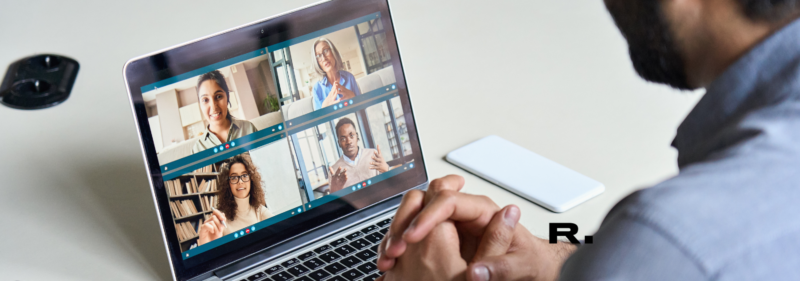Whether you’ve always been a remote-first company, or you’re just now stepping into the realm of remote or hybrid working: you’re going to need an excellent onboarding process and strategy for your remote employees.
Why? Your onboarding experience is vital. It sets the tone for your company.
Your people should feel excited to begin their work with you and feel connected to the company’s goals. If they do, they are more likely to be productive, engaged members of the team. Meanwhile, a lackluster onboarding process can kill all this enthusiasm and potential – and your staff retention can suffer as a result.
Embracing remote working comes with so many benefits (it’s why we love it here at RecruitmentJunky!). But you’ve got to set your employees up for success – and there are a few key differences to traditional onboarding.
If you’re improving your current processes, or scratching your head figuring out where to start, we’ve got you covered with our top tips below!
What makes remote onboarding different?
Unfortunately, it’s not enough to have a “one size fits all”’ onboarding process. You can’t expect office employees to onboard the same way as a remote employee – and if you do, that’s the first place you’re going wrong!
First of all, your onboarding is taking place entirely through technology, without any face-to-face interactions. You have to help your new employee find their footing, and really get stuck in with communicating.
Communication is vital for remote employees – and that’s why it’s essential you lay out expectations, have set preferred tools, and encourage employees to almost over-communicate at the beginning. Why?
- Your boss’ boss won’t just swing by the department office and ask to be introduced to the newbie they’ve spotted. You’ve got to encourage introductions with the company online instead.
- Creating a emotional bond online is tougher than IRL. Plus, remote working can feel very isolating if your employee isn’t used to it. That’s why good communication (such as using fun team meetings for socialising), can help develop team comradery and make sure a team member feels comfortable.
- Different timezones? A new way of working? Overload of information? You won’t be able to see if your new staff member is already hitting their head against a wall with so much going on. You need to have clear processes in place so that they don’t get lost with all the new info. They need to know the best channels for asking questions and the person(s) to message to find out what they need… and that these interruptions are normal!
- Remote working includes SO MUCH TRUST. You have to know that your new employee feels supported to get on with whatever work is initially set with them. That starts with clear communication.
So yes – remote onboarding does need a lot more documentation. But, it’s (arguably) more streamlined and faster than traditional onboarding. Cut out the fluff, and you can get right into onboarding for the role.
Remote onboarding starts from your first message.
Brilliant you have successfully conducted remote interviews and hired your new employee! But what’s next? Getting them involved and online ahead of their start date.
This may be your new employee’s first remote role (or not, considering how popular remote and hybrid roles are becoming). Either way, it is important to involve your new hire ahead of their start date. You don’t want them to feel isolated when they start – make them feel part of your team. We recommend:
- Communicate next steps. Ensure their manager communicates with them every step of the way (text, phone call, email – whatever is preferred!).
- Welcome onboard! Send a fully comprehensive introduction email with all the essentials at least 2 weeks before they start. We’re talking login details, confirmed start date and manager, a list of tools that will be used and a digital company handbook. You also need to:
- Ensure access to all relevant company tools, and include a basic “how to use” guide for tools.
- Include your company values, mission, and organisation charts in your handbook.
- Add some tips on how to get set up for successful remote/hybrid working.
- Invite the new employee to the main company communication channels (E.g. Slack) so they can have a stalk.
- Provide the paperwork. Contracts, your remote work policies, your benefits. Share company channels for them to follow (E.g. LinkedIn page), and relevant extras they will need to “feel part of the team” (E.g. email sign off template, LinkedIn banner image).
- Make it (inter)personal. Announce the new team member in the team chat, and in a team call, with a link to the new employee’s LinkedIn profile (so your current staff can send a personalised welcome message and connect).
- Go the extra step. Send a physical welcome pack / swag box.
- Take care of the tech. Check their equipment has been delivered at least 48 hours before they start, and offer help and instructions for setting up tech.
Your steps before their first day.
You need to set clear goals and tasks for your new remote employee BEFORE THEY START. Because they won’t be in the office daily with you hovering over their shoulder, watching their every move.
“We’re always watching Wazowski”
Time to get prepared. To start on the goal-setting, make a list of things you’d like them to achieve during their first three months on the job. Then figure out milestones in tasks or learning objectives for:
- The first month
- The 2-week mark
- The first week mark
- The first day
This way you can see what is needed at the beginning, to reach the end month goal. Plus, this method also often helps you realise if you’re expecting too much too soon from a new starter, or if you’re missing out on any steps for them to reach success.
Now you’ve got your goals, get organised on a plan. Figure out who the new starter needs to meet (and when) – then put the meeting in diaries now! Include video links, FAQ links, and plenty of time for questions. Plus, if an employee needs to brush up on some skills, or attend compliance training, include that in your plan. Share it with the new starter in their first few days, so you both know the expectations (just don’t overload them).
Buddies and mentors
Lastly, you could consider setting new employees up with a mentor or onboarding buddy. Buddies (not the restaurant) are such a help for new employees. New staff can ask FAQs to their buddy or mentor in advance and start building a bond. For instance, their buddy can show them who to go to for IT support and how comms tools are used in the company. (This saves you time as a manager too). A buddy can also give a new starter insight into the company and why they love working there. Just remember to stick remote workers with other remote workers – it doesn’t work as well if you cross the streams!
First day vibes.
Make their first day memorable! Consider starting the day off with a group coffee meeting for the company/department – especially if you have more than one new employee starting.
(If you want to make it extra special, splash out and order breakfast delivery or a care package to arrive in the morning!).
We tend to suggest a new employee take it easy on their first day at RecruitmentJunky, and let them finish the day or first week a little early. This is to avoid them feeling overwhelmed.
Ensure they have meetings planned for the first few days with all the core people they will need to interact with in their job. Plus allow time to look through key documents and get used to tools and systems. New employees need time to digest all this info, regardless of if they’re in the office or wfh.
Their first project.
It’s time for your new hire to get started on their first project (exciting stuff!). But first, let’s do a checklist…
- Do they have access to the tools they need?
- Have they been introduced to the people they need contact with?
- Have you taken into account how long this will take? And offered your continued support?
Once you can answer yes to these questions then your new hire is good to go.
Remember – be patient! As previously mentioned in our ‘What to do when you’ve hired the wrong person’ blog it typically takes an average of 28 weeks for a new hire to reach their optimal productivity in a new role. So don’t set the bar too high when they may still be learning.
It’s a great idea to get feedback throughout their probationary period (not just at the end). After each project is a good time to ask for their comments. This will help you mark their progress fairly. We suggest a survey at the end of their first week, and arranging a video call at the end of their first project. Collect verbal and written feedback and continue to keep the conversation open and transparent to improve your processes in the future.
Ongoing support.
The last step to having an effective onboarding process for your new remote employee is getting in touch frequently, and keeping good communication.
To start with you will need to schedule regular weekly meetings. This is important so you can closely work with them to discuss goals, the work they are doing, how they are finding it all and talk through any questions or concerns. Research shows that employees with proper ongoing support during onboarding are 54% more productive as new hires. So don’t let the support stop after the first few months. Keep the one-to-ones going with all employees – but gradually less often. (You don’t want them to feel micromanaged.)
To continue to improve your onboarding process it is important to gather feedback and refine your processes. Discuss it with the new employee – could it have been improved? Alternatively, send out an anonymous survey if you have a large group of new starters; this will save you time and you may find you receive more honest feedback with an anonymous survey.
Your ideal remote onboarding process
The most important thing to keep in mind is that your new employee needs time to adjust, and so do you. Don’t expect things to be perfect at first. Instead, understand that a successful remote onboarding process requires intentional planning and preparation on both sides of the screen.
Lastly – you should always be refining your processes! Improvements only come with experience, experimenting, and listening to feedback. Good luck!
Other Reads

10 Minute Read 06.05.22
5 tips on how to avoid making a bad hire
There is a lot of pressure surrounding hiring. You are likely already aware of the challenges you ma...

10 Minute Read 06.07.22
The best practical tips on how to conduct remote interviews
As a hiring manager, you probably know all the pros of moving to conduct remote interviews (even if ...

8 Minute Read 06.04.22
How to hire the right remote talent for your business
Hiring remote workers has become increasingly popular over the last two years due to the pandemic. A...